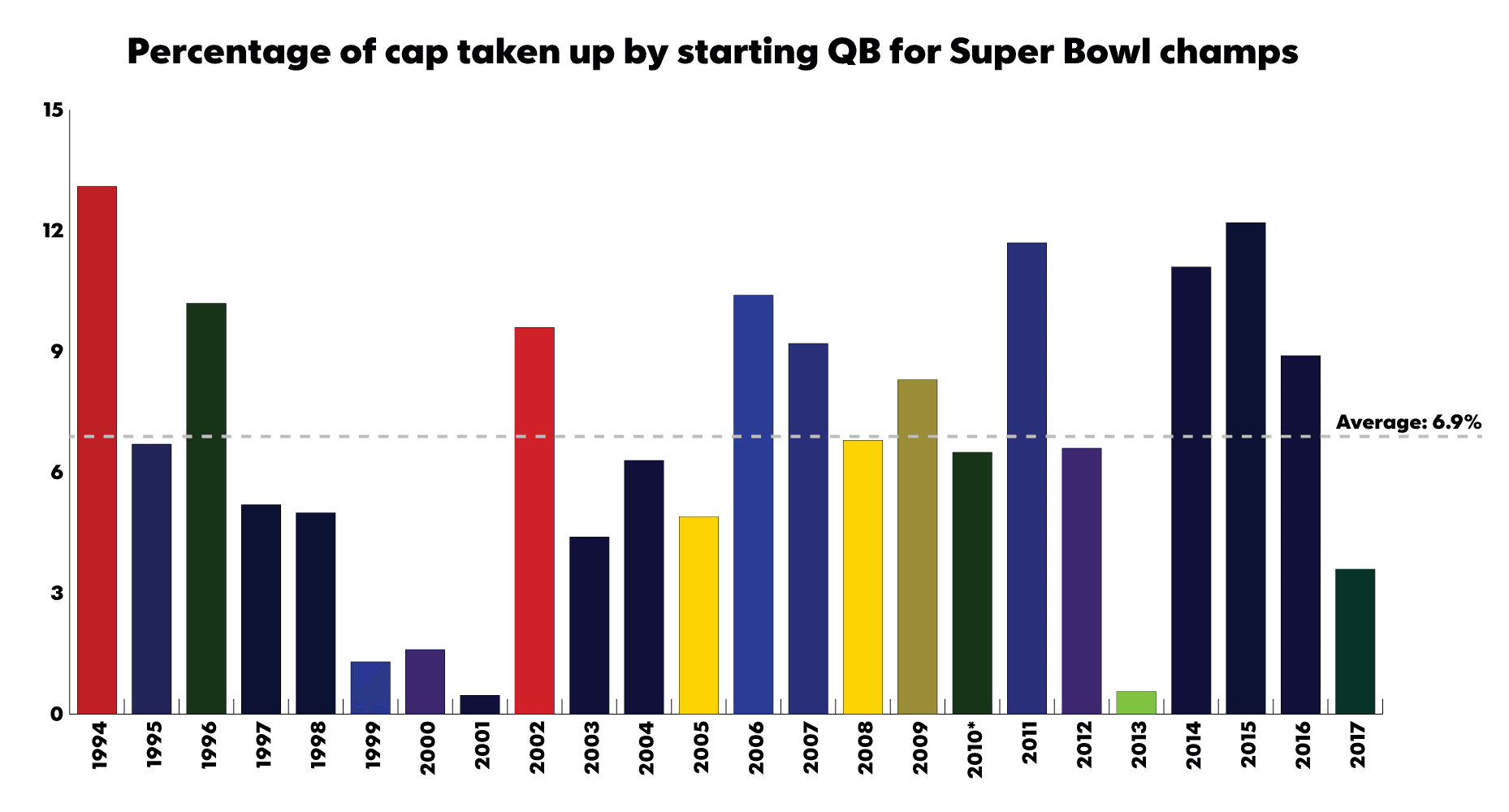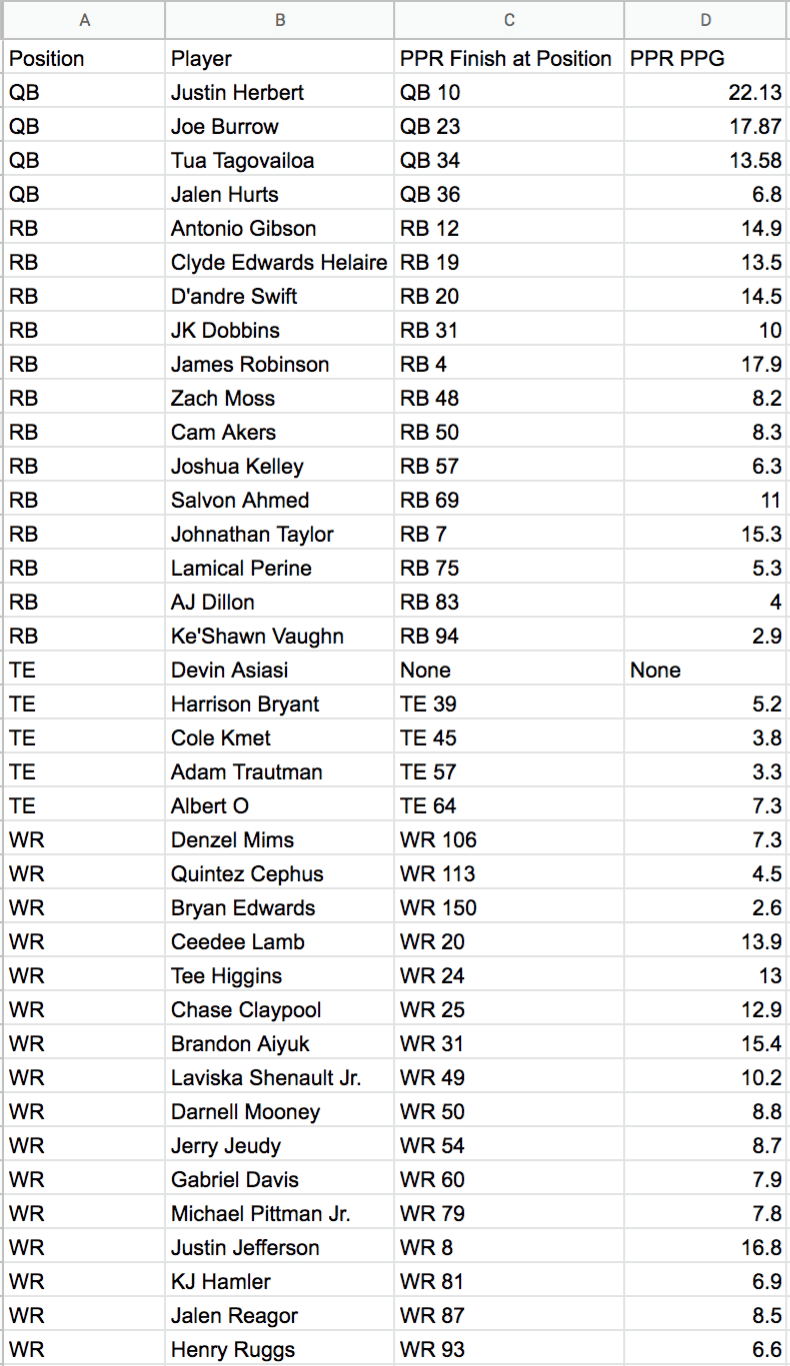This year, rookies outperformed against all odds. Without preseasons to establish chemistry, develop their skill sets, and learn offensive schemes, I predicted that rookies (especially WR/TE) should be faded as a whole, with only a few exceptions. Yet as players like Justin Jefferson and James Robinson proved, this rookie class was ready for action, bursting onto the scene at an unprecedented level. So what caused this? Is this a one-off year due to the historically strong 2020 rookie class, or is this predictive of future years? Do we need to re-evaluate how we think about positional breakout timings? Let’s examine these questions below.
2020 Rookie Class: An Overview
Here are the notable rookie finishes of 2020 (PPR, through 16 games):
(Click the image to view the entire database)
It’s unprecedented to have such rookie success from multiple positions, not restricted to the RB breakouts that occur relatively often. Here, the data speaks for itself regarding this year’s success, but how does this stack up against past years? Was this merely an anomaly?
Past Classes
Click here for rookie finish data from the past five years.
What does this data in the link above tell us? Let’s examine this data in windows. Let’s start in a three-year time period. Keep in mind that the 2019 and 2018 classes have had 2 or 3 years respectively to make an impact, so their recent production could skew the perception of the classes’ success in its rookie year. Regardless, we can see that last year’s class was superb, producing two (or three including Jalen Hurts) fantasy relevant QBs in their rookie seasons, with Justin Herbert leading the way as an every-week option for the majority of the season. Running back featured THREE RB1s, as well as two more RB2s. Wide Receivers were arguably the most shocking position, finishing with one WR1 (Justin Jefferson)! Additionally, three more WRs finished as top-25 options at the position. This year’s tight end class was weak, however intriguing prospects like Cole Kmet flashed this season, boding well for a breakout later on. Here is a summary of that data.
*Top-25 is included instead of top-24 since there were quite a few #25 finishes between multiple years, and I felt it best to include them in this summary. When examining these tables, keep in mind that the top 12 and top-25 columns are unequal, since becoming a top 12 player at a position is more challenging than a top-25 player. Thus, it is not appropriate to simply add the numbers in each table to assess the strength of a class. Additionally, positional finishes are unequal due to the competition and available players at a position (e.g. with WRs vs TEs, it’s arguably easier to become a top-25 TE than a top-25 WR due to competition at the position).
| 2020 | Top-12 | Top-25 |
| QB | 1 | 1 |
| RB | 3 | 2 |
| WR | 1 | 3 |
| TE | 0 | 0 |
Similar breakdowns for 2018 and 2019 are listed in the tables below.
2018 produced zero QB1s, two RB1s, one RB2, zero WR1s, one WR2, and three TE2s.
| 2018 | Top-12 | Top-25 |
| QB | 0 | 2 |
| RB | 2 | 1 |
| WR | 0 | 1 |
| TE | 0 | 3 |
In comparison, 2019 produced one QB 1, two top-25 QBs, zero RB1s, three top-25 RBs, no WR1s, two top-25 wideouts, and one TE2.
| 2019 | Top-12 | Top-25 |
| QB | 1 | 2 |
| RB | 0 | 3 |
| WR | 0 | 2 |
| TE | 0 | 1 |
This means that the 2020 class produced more top-12 RBs, more top-12 WRs, and just as many top-12 QBs/top-25 WRs than the previous two years combined! This is despite not having a preseason, and having modified online workouts take place of some practices.
Zooming out to a five-year view, we can see that the 2017 class was one of the best running back classes in NFL history, producing four rookie RB1s. There were no RB2s or RB3s in the class, however four RB1s is the highest total of any of the past five classes. When looking at the names though, it’s no surprise that this class had such high success, with Leonard Fournette, Alvin Kamara, Christian McCaffrey, and Kareem Hunt (the four RB1s), as well as Dalvin Cook, Joe Mixon, Marlon Mack, Aaron Jones, James Conner, Tarik Cohen, and Chris Carson. The remainder of the 2017 and 2016 classes are summarized below.
2017 produced one top-25 QB, four RB1s, one top-25 WR, one TE1, and three TE2s.
| 2017 | Top-12 | Top-25 |
| QB | 0 | 1 |
| RB | 4 | 0 |
| WR | 0 | 1 |
| TE | 1 | 3 |
2016 produced one QB1, one QB2, two RB1s, one WR1, another top-25 receiver, and one TE2.
| 2016 | Top-12 | Top-25 |
| QB | 1 | 1 |
| RB | 2 | 0 |
| WR | 1 | 1 |
| TE | 0 | 1 |
Looking at the entire data set, it appears that the 2020 season was significantly better than the average season during this interval. Even the strong 2017 season with its four rookie RB1s falls behind the 2020 season due to the differences in rookie WR production. There is no concrete, easily discernible rookie production trend over this time table (2017 and even 2016 were better in some areas than 2019 or 2018). Since position-by-position consistency varies year over year pretty significantly, it appears that the strength of a class (measured through scouting and evaluations pre- and post- draft) supersedes positional trends over time (for instance if the number of productive RBs steadily increased over time, or the number of QB1s/2s was seeing consistent growth year over year). Still, it seems that players are breaking out sooner than they have in the past. I think it’s time to reassess our old way of thinking about rookies, and acknowledge that rookies can breakout earlier on than previously thought, even in year one! This especially goes for rookie RBs, talented WRs with competent QB play, and even the occasional QB (especially with rushing capabilities, a la Kyler Murray). Let’s dive deeper into positional breakout timings.
*If you are interested in rookie data from before 2016, here is a graphic showing rookie finishes from 1990-2019 from Luke Neuendorf.
Typical Positional Breakout Timings
(Common timings I’ve seen before → New proposed timings (purely my opinion))
QB: 3 years → 2 years (The notorious year-2 breakout for QBs has yielded some of the top QBs for fantasy recently, eg. Patrick Mahomes, Lamar Jackson, Kyler Murray).
RB: 2 years → 1-early/mid-2 (Slight upgrade, however running back breakout timings have been relatively early for a while now, so the movement isn’t as large as it is for other positions).
WR: 3 years → 2-3 years (3rd year might be better, however I anticipate mini-breakouts in year 2 that yield most of the points of a 3rd year breakout).
TE: 3-4 years → 3 years (I think this breakout timing moves up slightly, however still within the 3-4 year range for the most part. I do believe this will catch up with the rest of the increases in due time, as TEs continue to be integral parts of successful NFL offenses, providing benefits as both large, powerful slot receivers and as an additional blocker. This dual-purpose is a contributor to the later breakouts, as tight ends are frequently called upon to perform both of these roles, which can slow breakout times. Due to the increasing importance of TEs however, I believe that there will be more emphasis placed on developing TEs in college, accelerating future breakouts).
Reasoning
Rookies are coming into the NFL more prepared, ready to make their impact on the game sooner than in past years. With franchises searching for coaches from the collegiate level to fill coordinator or head coach positions, schemes and play-calling continue to become more similar, closing the gap between college and the pros. Additionally, coaches and front offices are attached and attributed to their draft selections, and with the high turnover rate for most coaching staffs, teams are incentivized to use their rookies early and bring them along faster than ever before. This is especially true for high impact positions like QB, and this has only been exacerbated by the successful trend of surrounding a rookie-contract QB with elite talent, capitalizing on the few years prior to a major QB deal. Here is a graphic below detailing the Super Bowl winners’ QB salary cap percentage from 1994-2017 (Credit: Steven Ruiz of ForTheWin).

Additionally, preparation has improved, with better camps and training methods available for players even before college, as high schoolers or even younger. With the expansion of recruiting and social media, players are gaining exposure early on; they are provided unique opportunities that were not available before. Furthermore, with recent rule changes favoring offensive players, offenses are set to continue their recent successes, boding well for fantasy football.
While this inflates stats from players at different positions, with the focus on QB safety and preventing injuries, passing benefits a lot, supporting higher numbers for QBs and WRs. With the growing shift towards RBBCs in the NFL, this could help close the scoring gap between RBs and WRs in fantasy, which could eventually lead to new scoring formats as the balance shifts in the NFL.
Conclusion
We need to reevaluate how we perceive rookies, and recognize that rookie breakouts are possible, especially at running back. Additionally, as breakouts happen earlier and earlier, our mindset should change to reflect that. In order to find which rookies to target in your leagues, here’s some advice from Jax Falcone: “In the long term, talent wins out. In the short term, opportunity is key.” For redraft, opportunity reigns supreme, at least early on. In contrast, targeting talent (even in muddled situations) can yield massive returns in dynasty leagues.
Follow Vivek Iyer on Twitter for more fantasy football content! Special thank you to Jax, Chalk, and Marc for their help on this article! Thank you for reading!
